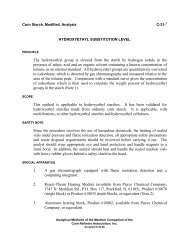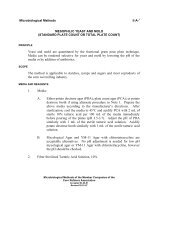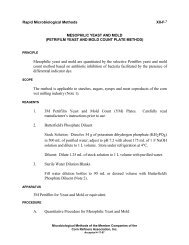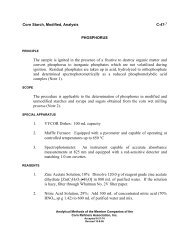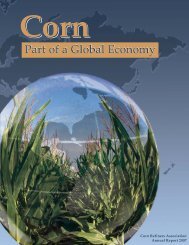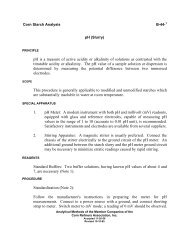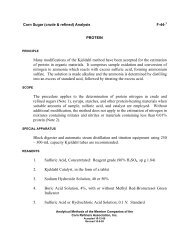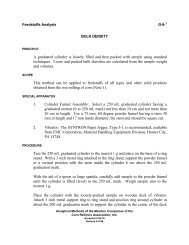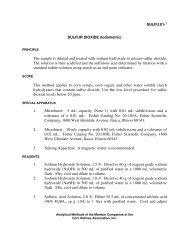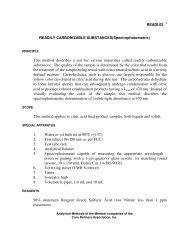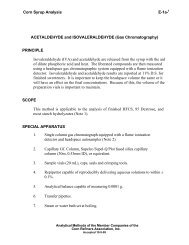Products
Corn Wet Milled Feed Products Corn Wet Milled Feed Products
Corn Wet Milled Feed Products Corn Wet Milled Feed Products
- No tags were found...
You also want an ePaper? Increase the reach of your titles
YUMPU automatically turns print PDFs into web optimized ePapers that Google loves.
Corn WetMilled Feed<strong>Products</strong>
CONTENTSMember Companies and Plant Locations ............................ 2Foreword ............................................................................. 3The Corn Crop .................................................................... 4The Corn Kernel .................................................................. 5The Corn Wet Milling Process ............................................ 6Composition of Wet Milled Feed <strong>Products</strong> ......................... 8Applications of Wet Milled Feed <strong>Products</strong> ........................11Nutrient Values of Wet Milled Feed <strong>Products</strong> ...................19Analytical Examination of Feed <strong>Products</strong> ..........................24Literature Cited ..................................................................25CONTENTSTABLES1. Proximate Analysis of Yellow Dent Corn Grain ............ 52. Composition of Corn Wet Milled Feeds .......................203. Nutrient Composition of Corn Wet Milled Feeds .........214. Mineral Content of Corn Wet Milled Feeds ..................225. Amino Acid Content of Corn Wet Milled Feeds............23FIGURES1. The Corn Kernel ............................................................. 52. The Corn Wet Milling Process ....................................... 7Corn Refiners Association1701 Pennsylvania Avenue, N.W.Washington, D.C. 20006-5805202-331-1634 Fax: 202-331-2054www.corn.org4th EditionCopyright 20061
MEMBER COMPANIESArcher Daniels Midland CompanyP.O. Box 1470Decatur, Illinois 62525Cargill, IncorporatedP.O. Box 5662/MS62Minneapolis, Minnesota 55440-5662Corn <strong>Products</strong> International, Inc.5 Westbrook Corporate CenterWestchester, Illinois 60154National Starch and Chemical Company10 Finderne AvenueBridgewater, New Jersey 08807-0500Penford <strong>Products</strong> Co.(A company of Penford Corporation)P.O. Box 428Cedar Rapids, Iowa 52406-0428Roquette America, Inc.1417 Exchange StreetKeokuk, Iowa 52632-6647Tate & Lyle Ingredients Americas, Inc.(A subsidiary of Tate & Lyle, PLC )P.O. Box 151Decatur, Illinois 62521PLANT LOCATIONSPlants:Cedar Rapids, Iowa 52404Clinton, Iowa 52732Columbus, Nebraska 68601Decatur, Illinois 62525Marshall, Minnesota 56258-2744Plants:Blair, Nebraska 68008-2649Cedar Rapids, Iowa 52406-2638Dayton, Ohio 45413-8001Decatur, Alabama 35601Eddyville, Iowa 52553-5000Hammond, Indiana 46320-1094Memphis, Tennessee 38113-0368Wahpeton, North Dakota 58075Plants:Bedford Park, Illinois 60501-1933Stockton, California 95206-0129Winton-Salem, North Carolina 27107Plants:Indianapolis, Indiana 46221North Kansas City, Missouri 64116Plant:Cedar Rapids, Iowa 52404-2175Plant:Keokuk, Iowa 52632-6647Plants:Decatur, Illinois 62521Lafayette, Indiana 47902Lafayette, Indiana 47905Loudon, Tennessee 377742
Corn is the basic food plant of modern America and by far its mostversatile grain. The end products in which it is found are often farremoved from the farmer's field. Corn refining plays a major rolein the change from the golden ears of autumn to the beef, chicken,eggs, fish and other foodstuffs that grace our dining room tables.From the corn refining (wet milling) process comes protein, fiber,minerals and vitamins to feed the cattle, fish, hogs and poultry thatenrich our diets. Corn wet milling feed products are an abundantsource of protein and energy. About 14 million tons, roughly 25 to30 percent of the corn used by the corn refining industry goes intofeed products.FOREWORDThe remarkable growth of the corn refining industry has madeincreasing quantities of high quality animal feed ingredients availableto U.S. and world markets. Along with this growth has comethe need for updated information about the use of corn wet milledfeed ingredients in animal rations. Members of the Corn RefinersAssociation, government agencies, universities and private institutionsall contribute to the vast resources of nutritional informationnecessary to develop the most nutritionally efficient and economicallybeneficial rations.The Corn Refiners Association hopes that all those concerned withfeed formulation and animal nutrition will find this booklet informativeand useful in their day to day work. It describes briefly the processyielding the important ingredients coming from corn refining,reviews their special properties, presents compositional data necessaryfor using them in ration formulation and discusses use of theproducts in feeding various classes of animals. While we hope thatthe information provided is valuable, readers should understand thatthe feed industry is constantly changing. Researchers are continuallydiscovering new uses for corn derived products, furthering theknowledge of animal feeding requirements and applying their discoveriesto the nutritional needs of the world's population.Audrae EricksonPresidentCorn Refiners AssociationReaders are advised that the information and suggestions containedherein are general in nature and that specific technical questionsshould be referred to the Association or member companies. Questionsconcerning the price and/or availability of products describedshould be directed to individual Association members.3
THE CORN CROPCorn (Zea mays) is grown inevery state: It is truly anAmerican crop. The UnitedStates has had an averageannual corn production of10.3 billion bushels for theyears 2001 through 2005. Tocomprehend this amount ofcorn, imagine that all thecorn was loaded onto railcars linked end to end. Asingle train loaded with theaverage corn crop wouldmore than encircle theglobe. Another way to envisionthis quantity of corn isto realize that if the averagecorn crop was dividedequally among all Americans,every man, woman andchild would receive over 34bushels—a bushel equals 56pounds.Corn is a very versatile grainthat benefits mankind inmany ways. Each year, 6billion bushels of corn areused as feed for cattle, hogsand poultry in the UnitedStates. Another 2 billionbushels are exported, whichis an integral part of thiscountry's balance of trade.Approximately 2.9 billionbushels are converted tosweeteners, starch, flour,cereal, liquor, animal feeds,vegetable oils, alcohol forfuel and hundreds of otherproducts.This portion of the crop isprocessed by three majorindustries: corn refiners,who produce starches, sweeteners,ethanol, feed ingredients,corn oil, organic acids,amino acids and polyols; drymillers, who produce flakinggrits, snack grits, corn mealsand corn flours; and distillers,who produce beverageand industrial alcohol. Thelargest of these industries,corn refiners, uses approximately15 percent of annualcorn production. Each ofthese industries also suppliesfeed ingredients. These cornderived feed ingredientsconsist primarily of the portionsof corn remaining afterextraction of primary productssuch as starch, flour andgrits. Different manufacturingprocesses are used byeach of these industries.4
Corn kernels have threemain parts, the seed coat orpericarp, the starchy endosperm,and the embryo,commonly called the germ(Figure 1).The pericarp is the outerskin or hull of the kernelwhich serves to protect theseed. The endosperm, themain energy reserve, makesup about 80 percent of thetotal weight of the kernel. Itis about 90 percent starchand 7 percent gluten (protein),with the remainderconsisting of small amountsof oil, minerals and sometrace constituents.Typical composition of corngrain is shown in Table 1.The embryo contains a min-Endospermiature plant made up of aroot like portion and five orsix embryonic leaves. Inaddition, there are presentlarge quantities of high energyoil to feed the tiny plantwhen it starts to grow, aswell as many substancesrequired during germinationand early development.StarchStarchandGlutenGermHull andFiberFigure 1.A Kernel of Corn.THE CORNKERNELCharacteristic Range AverageMoisture (% wet basis) 7 – 23 16.0Starch (% dry basis) 61 – 78 71.7Protein (% dry basis) 6 – 12 9.5Fat (% dry basis) 3.1 – 5.7 4.3Ash (oxide) (% dry basis) 1.1 – 3.9 1.4Pentosans (as xylose) (% dry basis) 5.8 – 6.6 6.2Fiber (neutral detergent residue) (% dry basis) 8.3 – 11.9 9.5Cellulose + Lignin 3.3 – 4.3 3.3(acid detergent residue) (% dry basis)Sugars, Total (as glucose) (% dry basis) 1.0 – 3.0 2.6Total Carotenoids (mg/kg) 12 – 36 26.0Table 1.Proximate Analysis ofYellow Dent CornGrainReprinted with permission form White, P.J., and Johnson, L.A., eds., 2003, CornChemistry and Technology, American Association of Cereal Chemists, St. Paul, MN.5
THE CORN WETMILLING PROCESSIn the corn wet milling process,(Figure 2), the kernel isseparated into its componentparts, and those parts arethen further subdivided andrefined.The wet miller buys shelledcorn which is delivered tohis plant by truck, barge orrail car. Normally #2 gradecorn is purchased, based onU.S. Department of Agriculturestandards. The first stepin the process is to clean thegrain to remove extraneousmaterial such as pieces ofcob, foreign seeds, straymetal, fine dirt, or light unwantedmaterial. It then isconveyed to storage silos,holding up to 350,000 bushels,until ready to go to therefinery.The cleaned corn is transportedto large tanks calledsteeps. Warm water (125 o130 o F) containing smallquantities of dissolved sulfurdioxide is circulated throughthe steeps for approximately40 hours. Soaking softensthe kernel and the dilutesulfurous acid formed byinteraction of the sulfur dioxideand water (SO 2+ H 2O= H 2SO 3), controls fermentationand assists in separationof the starch and protein.During steeping, thesoluble components are extractedfrom the intact kernel.At the conclusion ofsteeping, the water is drainedfrom the kernels and concentratedin multiple effectevaporators to yield concentratedsteepwater. This proteinrich extract may be usedas a nutrient for microorganismsin the production ofenzymes, antibiotics andother fermentation products.The major portion, however,is combined with fiber andgluten in the production ofanimal feed ingredients.The softened corn kernelsnext pass through attritionmills to break them up,loosen the hull and free thegerm from the endosperm.Wateris added to theattrition mills and a thickslurry of macerated kernelsand whole germ results. Becausethe germ at this stagecontains 40-50 percent oil itis lighter than the endospermand hull. Centrifugalforce is used to isolatethe germ.The clean, separated germ isthen dried and the crude oilis removed by mechanicalpresses and/or solvent extraction.The crude oil maybe refined to yield a finequality salad and cooking oilor a raw material for thepreparation of corn oil margarines.The extracted germmeal is used in animal feed.Further information on productionand use of corn oil6
○ ○ ○ ○ ○ ○ ○ ○ ○ ○○ ○ ○ ○ ○ ○ ○ ○ ○ ○ ○ ○ ○ ○ ○ ○ ○ ○ ○ ○ ○ ○ ○ ○ ○ ○ ○ ○ ○ ○ ○ ○ ○ ○○ ○ ○ ○ ○ ○ ○ ○ ○ ○ ○ ○ ○ ○ ○ ○ ○ ○ ○ ○○ ○ ○ ○ ○ ○ ○ ○ ○ ○ ○ ○ ○ ○ ○ ○ ○ ○ ○ ○ ○○ ○ ○ ○ ○ ○ ○ ○ ○ ○ ○ ○ ○ ○ ○ ○ ○ ○ ○○ ○ ○ ○ ○ ○ ○ ○ ○ ○ ○ ○ ○ ○ ○○ ○ ○ ○ ○ ○○ ○ ○ ○ ○ ○ ○ ○ ○ ○ ○ ○ ○ ○○ ○ ○ ○ ○ ○ ○ ○ ○ ○ ○ ○ ○ ○ ○ ○ ○ ○ ○ ○ ○ ○○ ○ ○ ○ ○ ○ ○ ○ ○ ○ ○ ○ ○ ○ ○ ○ ○ ○ ○ ○ ○○ ○ ○ ○○ ○ ○○ ○ ○ ○ ○ ○ ○ ○ ○may be found in the bookletCorn Oil available from theCorn Refiners Associationwebsite, www.corn.org.The remaining mixture ofhull and endosperm thenpasses through a series ofgrinding and screening operations.The hull particles areremoved on screens, whilethe finer particles of proteinand starch pass through. Thehull is used as a constituentin animal feed or for productionof refined corn fiber(bran) for food use.Next, the water slurry ofstarch and gluten is separatedin centrifuges. Becausestarch and gluten differ indensity, almost completeseparation is obtained. Typicaloperations yield a glutenstream containing over 60percent protein, while thestarch stream is over 99 percentstarch. The gluten isdried and sold as glutenmeal (60 percent protein) orit may be used as an ingredientin corn gluten feed (21percent protein).The white, nearly purestarch slurry is furtherwashed to remove smallquantities of solubles. Atthis stage the starch slurryShelled CornFigure 2The Corn Wet Milling ProcessCorn CleanersSteep TanksGermSeparatorsGrinding MillsScreensCentrifugalSeparatorsHydrocloneStarch WashingSteepwaterGermFiberGlutenRefinerySteepwaterEvaporatorsCornOilFeed <strong>Products</strong>Germ Washingand DryingClean, DryGermGermExtractorsCorn GermMealCorn SteepLiquorCorn GlutenFeedCorn GlutenMealStarch<strong>Products</strong>NutritiveSweetenersFermentationand Other Chemicals7
COMPOSITIONOF WET MILLEDFEED PRODUCTSmay be diverted to makesweeteners or further processedto make any common(unmodified) corn starch.Various modified orderivatized starches may beproduced by treating theslurry of washed starch withchemicals or enzymes. Aftertreatment, the products arerecovered by filtration orcentrifugation and the starchis dried. Information on thestarch and sweetener productsof the corn wet millingindustry may be found in thebooklets Corn Starch andNutritive Sweeteners fromCorn available from theCorn Refiners Associationwebsite, www.corn.org.The four major feed productsderived from corn wetmilling are described as followsby the Corn RefinersAssociation:Corn gluten feed is thatpart of commercial shelledcorn and process residualsthat remain after the extractionof the larger portion ofthe starch, gluten and germby the process employed inthe wet milling manufactureof corn starch and cornstarch derivatives. It may ormay not be pelletized, andmay or may not containcorn steep liquor and/orcorn germ meal. It may containup to 0.5 percent byweight of a nutritive or nonnutritive,inert, non-toxicconditioning agent to improveflowability. It may notcontain other products thatare blended or admixed afterits initial manufacture, orafter pelleting.Corn gluten feed is a mediumprotein, medium energyingredient. It is widelyused in complete feeds orconcentrate for dairy andbeef cattle, poultry (layerand turkey breeders), swine,and as a carrier for addedmicronutrients. It is commonlyprovided at around 20percent protein at 10 percentmoisture.A number of facilities alsooffer wet corn gluten feed.Wet corn gluten feed ismade by screening and pressingwet corn fiber to reducethe water content. It can besold as is, or combined withsteep liquor, corn germ mealor fermentation residues toproduce a product with approximately40 to 60 percentdry matter. Wet corn glutenfeed is commonly used indiets for feedlot cattle anddairy cattle.Corn gluten feed is a majorproduct in internationaltrade in feed ingredients andlarge volumes of U.S. corngluten feed are exported to8
the European Union. A bilateralagreement betweenthe U.S. and the EU providesadditional requirements forcorn gluten feed exported tothe European Union that arecontained in the EuropeanUnion Harmonized TariffSchedules. That definitionstates that the applicabletariff number for corn glutenfeed "includes only residuesfrom the manufacture ofstarch from maize, and doesnot cover blends of suchresidues with products derivedfrom other plants orproducts derived from maizeotherwise than in the courseof the production of starchby the wet process, containing:screenings from maizeused in the wet process in aproportion not exceeding 15percent by weight, and/or;residues of maize steep-water,from the wet process,including residues of steepwaterused for the manufactureof alcohol or otherstarch derived products;These products may alsocontain residues from theextraction of maize germ oilby the wet milling process."European Union customs*regulations also specify limitsfor starch, fat and proteincontent for imported corngluten feed. The Corn RefinersAssociation makes availablea program for U.S. producersto certify that theirexports meet these definitionsand analytical requirements.This certificate, alongwith a certificate of analysisfrom the USDA FederalGrain Inspection Service, isrequired by the EU as a conditionof normal customstreatment.Corn gluten meal is a highprotein, high energy ingredientconsisting of protein(gluten) separated in thecorn wet milling process incombination with minimalquantities of starch and fibrousfraction not recoveredin the primary separation.* The combined customs nomenclature of the EU places corngluten feed in tariff classification 2309.90.20 with the followingadditional requirements: “Their starch content may not exceed28% by weight on the dry product in accordance with the methodcontained in Annex I(I) to Commission Directive 72/199/EEC,their fat content may not exceed 4.5% by weight on the dry productdetermined in accordance with method A contained in AnnexI to Commission Directive 84/4/EEC and their protein contentmay not exceed 40% on the dry product determined in accordancewith the method contained in Annex I(2) to Commission Directive72/199/EEC.” (See http://ec.europa.eu/taxation_customs/customs/customs_duties/tariff_aspects/combined_nomenclature/index_en.htm)9
This high energy proteinconcentrate is commonlyprovided at 60 percent protein.Corn gluten meal is avaluable source of methionineto complement othercommonly used proteinsources. The high xanthophyllcontent of corn glutenmeal makes this productparticularly valuable as anefficient pigmenting ingredientin poultry feeds. Corngluten meal is also an excellentfeed ingredient forcattle, providing a high levelof rumen-protected protein.Corn germ meal is a mediumprotein, medium energyingredient obtainedfrom the corn germ fractionafter the corn oil has beenremoved.Since germ represents only asmall portion of the kernel,only a limited quantity ofcorn germ meal is available.It is generally used as aningredient in corn glutenfeed. It is useful as a carrierfor liquid nutrients and iscommonly provided at 20percent protein.Corn steep liquor (alsoknown as condensed fermentedcorn extractives) is,on a dry matter basis, a highprotein, high energy liquidingredient consisting of thesoluble portions of the cornkernel removed by the steepingprocess and concentratedto high solids.Corn steep liquor is sometimescombined with otheringredients in corn glutenfeed or may be sold separatelyas a liquid proteinsource for beef and dairyfeeding, or as a nutritionalpellet binder. It is a valuablesource of B-vitamins, mineralsand unidentified growthfactors.Amino acids produced bycorn wet millers throughfermentation of dextroseprovide a vital link in animalnutrition systems. Mostgrain feeds do not have theamount of lysine requiredby swine and poultry foroptimal nutrition. Economicalcorn based lysine is nowavailable worldwide to helpsupplement animal feeds.Threonine and tryptophanfor feed supplements producedfrom corn are alsoavailable.10
Optimum nutrition of eachclass of livestock and poultryis of primary concern to thefeed manufacturer. Each of thecorn wet milled feed productscontributes different nutritionalcharacteristics to thefinished feed in which they areused. In general, the four majoringredients supplied byrefiners are classified as “proteinsupplements” accordingto the National ResearchCouncil. In addition to therange of total protein content,the four feedstuffs each havedifferent levels of various essentialamino acids, vitaminsand minerals.With numerous ingredients tochoose from, feed formulatorsgenerally use computer solutionsfor feed compoundingquestions. Information is enteredconcerning the nutritionalcharacteristics of eachavailable ingredient, its priceand availability. Then thenutritional needs of the animalbeing fed are entered. Thecomputer program recommendsa complete feed for theanimal, meeting all its nutritionalrequirements fromavailable ingredients. With theuse of computer modeling topredict nutrient requirements,nutrient management is improvedthrough less overfeeding,increased efficiency ofnutrient utilization, maximizedperformance and enhancedeconomic benefit.While much of today’sfeed formulation involveseconomic considerations,specific properties of severalwet milled feed products,aside from price, contributemuch to theirusage.Beef CattleRuminants, such as beefand dairy cattle and sheep,are unique as food producersin that they can combinecarbon skeletons,obtained from fermentationof cellulosicfeedstuffs, and nitrogenfrom other sources to producemeat, milk and wool.However, to maximizeefficiency of production,high producing dairy cowsand rapidly growing calvesrequire supplemental proteinwhich escapes ruminaldegradation and is digestedand absorbed in the smallintestine.Corn gluten meal wasfound to be an effectiveprotein source for beefcattle as early as 1933 1 .Corn gluten meal plusurea was equal to soybeanmeal in supporting growthof calves and lambs 2 . Corngluten meal was an effectivesubstitute for soybeanmeal when alternating dayprotein supplementationof cattle grazing cornstalks3 . Corn gluten meal isAPPLICATIONSOF WET MILLEDFEEDPRODUCTS11
an excellent source of slowlydegraded protein 4-6 withapproximately 60 percent ofthe protein escaping the rumen7, 8 and passing into thesmall intestine where it isreadily absorbed 9 . For example,the quantity of lysineabsorbed from the smallintestine was similar whenan equal amount of corngluten meal and soybeanmeal protein was fed. Thehigh rumen escape of lysinein corn gluten meal relativeto soybean meal, and highbioavailability of the corngluten meal protein, madethis possible.The potential for corn glutenmeal to improve efficiencyof protein utilization hasbeen demonstrated in thegrowing calf 6 and high producingdairy cow 10, 11 . Corngluten meal in combinationwith other nitrogen sourcesoffers the opportunity toformulate supplementswhich are nutritionallyequal to many natural proteinsupplements, but with aconsiderable cost savings.Corn germ meal has beenshown to be an excellentsource of supplemental fat inbeef finishing diets 12 .Corn steep liquor has beendemonstrated to be a usefulingredient in beef cattle feeding.Up to 15 percent wassuccessfully fed in concentratemixtures for growingcrossbred calves 13 . Adding 5percent steep liquor concentrateto corn forage atensiling significantly increaseddigestibility of drymatter, crude protein, crudefiber and nitrogen-free extract(NFE) with growingcattle 14 . Corn steep liquorwas an effective proteinsource for wintering dry,pregnant cows on nativerange 15, 16 .Dry corn gluten feed pelletsare an excellent source ofprotein, energy and mineralsin beef cattle diets. Corngluten feed, either as dry,wet or ensiled, could be substitutedfor up to 50 percentof the dry matter in highconcentratediets for cattleand sheep, comparing favorablywith corn + urea orcorn + soybean meal diets 17 .High dietary levels (up to 80percent of the diet) supportedcattle gains that werenearly equal to those ofcattle fed corn silage 18 .Growing steers fed cornsilage-based diets supplementedwith dry corn glutenfeed pellets grew faster andrequired less feed per unit ofgain than did those fed asimilar diet supplementedwith soybean meal 19 . Thevery low acid detergent insolublenitrogen values ofcorn gluten feed suggest thatthe crude protein is nearly12
100 percent available 20 . Indiets for growing-finishingcattle, corn gluten feed pelletswere found to have 86-90percent of the energy ofcorn 21, 22 . When supplementinghigh-forage growing diets,the corn gluten feed wasfound to be equal to corn inenergy due to the complementaryeffects on ruminalfiber digestion 18, 23, 24 . Thiscomplementary effect occursbecause the fiber-digestingmicrobial population in therumen is maintained withcorn gluten feed; whereas ashift towards a starch digestingmicrobial populationoccurs when high-starchcereal grains are fed. This isespecially important whensupplementing beef cows fedhay-based diets 25, 26 . The highphosphorus content of corngluten feed is also an asset inphosphorus deficient highforagediets. Corn glutenfeed is an effective supplementfor beef cattle grazingnative range 27-29 or fed nativegrass or prairie hay 26, 30 .Wet corn gluten feed ismade by screening and pressingwet corn fiber to reducethe water content so thatwhen combined with steepliquor, the final productcontains approximately 40percent dry matter. Wetcorn gluten feed is very palatableand tends to increasedry matter intake whenadded to feedlot diets. Becauseof its high digestibility,wet corn gluten feed isan excellent source of protein,energy and roughage inmedium to high energy dietsfor feedlot cattle 17 . Wet corngluten feed has an energyvalue as high as 95 percent ofcorn on an equal dry matterbasis when fed in typicalfeedlot diets. This value maybe even higher if part of theroughage is replaced withwet gluten feed or if the dietsare fed at restricted intake.The need for additionalroughage is greatly reducedor eliminated when 50 to 70percent wet corn gluten feedis fed in a finishing diet 22 .Dairy CattleDairy cattle also benefitfrom the excellent feedingvalue of corn gluten feed.Dry corn gluten feed canincrease feed intake andmilk production when addedto typical corn-corn silagelactation diets. Diets containingas much as 60 percentdry corn gluten feed havebeen fed successfully to lactatingcattle 31 . Changingrations of lactating cows toinclude 20 percent dry corngluten feed and 20 percentconcentrate in place of 40percent concentrate did notaffect feed intake, milkyield, milk composition,body condition or levels ofmetabolites or minerals in13
lood serum 32 . Up to 27percent of dietary dry matterwas successfully includedwithout loss of milk yield,percentage of milk proteinand non-fat solids 33 . A combinationof 20 percent corngluten feed and 1 percentsodium bicarbonate was aneffective replacement forneutral detergent fiber(NDF) from corn silage 22 .Dried corn gluten feed wasfound to be a satisfactorysource of energy, proteinand fiber when it comprised15 to 20 percent of feed drymatter 34 .Wet corn gluten feed is alsoan excellent source of protein,energy and digestiblefiber for lactating dairycows. Fat-corrected milkproduction was maintainedwhen wet corn gluten feedreplaced corn and soybeanmeal at 25-30 percent of thediet dry matter in corn-cornsilage based diets 35, 36 . Milkfatpercentage increasedlinearly as dietary level ofwet corn gluten feed increasedfrom approximately20 to 40 percent 36, 37 . Researchsuggests that wet glutenfeed can replace at least33 percent of the neutraldetergent fiber in foragebaseddiets for dairy cattlewithout changing theacetate:propionate ratio 38 ,which is necessary for maintaininghigh milk fat levels.When wet corn gluten feedwas fed as 90 percent of thediet to dairy replacementheifers, daily gain and feedefficiency were significantlyimproved compared withheifers fed alfalfa haylage,oatlage or sorghum-soybeansilage based diets 39 .Corn steep liquor has becomean important source ofprotein, energy and phosphorusin liquid feed supplementsfor beef and dairycattle. Corn steep liquor isequal to soybean meal andequal or superior to urea as acrude protein source in feedlotdiets 40, 41 . A liquid supplementcontaining 71 percentcorn steep liquor was equalto cottonseed meal as asupplemental protein sourcefor cows grazing dormantnative range. Supplementblocks are often used to providenutrients for rangecattle. Corn steep liquorserves as both a nutrientsource and binder in manyrange block formulations. Apelleted combination of rawsoybean hulls and condensedcorn steep liquorsuccessfully replaced a portionof the forage, grain andsoybean meal in diets forlactating dairy cows withoutdecreasing lactational performance42 . Corn steep liquorwas fed at 10 percent levelsin concentrate mixtureswithout affecting the produc-14
tion and efficiency of lactatingcows with an economicadvantage 43 .SheepThe nutritive value of corngluten meal for sheep hasbeen known for manyyears 44, 45 . Dry and wet corngluten feed are excellentsources of nutrients forgrowing lambs 22, 46 . Lambsfed diets containing 50 percentdry corn gluten feedpellets grew as fast as lambsfed corn based diets supplementedwith sunflower orsoybean meal 19 . Dietarycorn gluten feed levels above50 percent of the diet are notrecommended in order toavoid copper toxicity 19 .When finishing lambs werefed diets containing 25 or 50percent dry corn gluten feed,which was substituted on anequal dry matter basis forcorn silage, rate of gain andfeed efficiency were improved47 . On an equal-proteinbasis, dry corn glutenfeed was equal to corn plussoybean meal for finishinglambs 17 . Corn gluten mealcan be used to partially replacecorn and soybean mealin diets for lambs 48 , feedlotsheep 49 and lactating ewes 50 .PoultryNutritional requirements ofpoultry vary greatly, dependingon type of bird and stageof production. Recognitionof the value of corn glutenmeal was noted in 1935 inturkey diets 51 and in 1939 indiets for chicks and layinghens 52 . Corn gluten meal isused frequently in broilerdiets due to its unique nutritionalqualities. Because of itshigh protein (60 percent) andenergy content, it is ideallysuited for the nutrient-densehigh-efficiency diets soughtby the broiler industry. Feedingtrials have demonstratedthat corn gluten meal canreplace animal protein indiets for broilers 53-55 . Corngluten meal is high in xanthophylls,the carotenoid pigmentswhich give egg yolksand poultry their goldenyellow pigmentation 56 . Thexanthophyll from corn glutenmeal has been shown to havehigh value in pigmentingbroiler skin 57 and the yolksof eggs 58 . Energy content ofcorn gluten meal is secondonly to that of pure fats andoils among available ingredients.The high linoleic acidcontent is also important inhelping to meet the relativelylarge essential fattyacid requirements of chickens59 . Corn gluten meal isalso high in methionine, anessential amino acid deficientin many feed ingredients.The methionine in corngluten meal is highly digestibleby chicks 60 , being approximately98.9 percentdigestible. The lysine and15
metabolizable energy (ME)of corn gluten meal is alsohighly digestible 61 .Corn gluten feed can be substitutedfor 15 percent of thecorn and soybean meal inbalanced diets of layinghens, without decreasingfeed efficiency or egg production62, 63 . Some studieshave demonstrated that ashigh as 20 percent corn glutenfeed could be included inlayer diets without a negativeimpact on economicproduction 64 . Recent researchshows that the metabolizableenergy value ofcorn gluten feed for broilerscan be as high as 2.8 to 3.1Kcal/g, which is muchgreater than the 1.8 Kcal/g inthe 1994 NRC requirementsfor poultry 56, 65 .With the rapid expansion ofthe turkey industry, there isconsiderable opportunity tomake efficient utilization ofcorn gluten feed in turkeyproduction. Turkey poultscan effectively utilize 10-20percent corn gluten feedwhen diets are balanced tobe isocaloric andisonitrogenous to typicalcorn-soy basal diets 66 .Corn germ meal is an excellentsource of amino acidsfor poultry due to the desirablebalance of essentialamino acids and its highenergy content. Up to 22percent corn germ mealcould be successfully used inbroiler diets 67 while the inclusionof up to 50 percentcorn germ meal in layerdiets did not affect the performance,internal egg qualityor egg shell quality 68 .Dried corn steep liquor concentrateis a useful productin diets for broilers 69-72 , layinghens 73 and turkeys 73 .Inclusion of corn steep liquorconcentrate in layerdiets results in an improvementin internal albumenquality as indicated by increasedHaugh units 73, 74 thatmay be economically beneficialin older hens whereinterior egg quality typicallydeclines.SwineThe first trial evaluatingcorn wet milled feed productsfor swine was conductedin 1920 75 . Since thattime, our understanding ofthe pig’s nutrient requirementsand the ability of cornwet milled feed products tomeet these requirements hasbecome much more sophisticated.Corn germ meal hasbeen shown to be equal tosoybean meal as a proteinsource for the growing pig 76 .Defatted corn germ meal hasbeen demonstrated to beeffective in diets for growingand finishing pigs at levels of16
15 to 40 percent of the diet 77-79 .Pelleted corn gluten feed canreplace up to 30 percent of thecorn in a corn-soybean mealdiet for the finishing pig withoutreducing performance 80-84 .If supplemental lysine andtryptophan are added, corngluten feed can replace bothcorn and soybean meal at levelsup to 30 percent of the diet.Pelleting corn gluten feed improvesnitrogen retention byincreasing tryptophan and/orenergy availability. Corn glutenfeed contains approximately80 percent of the energyof corn for the growingpig 85 . Corn gluten feed has anME value of 2.77 Kcal/g of drymatter 86 . For gestating sows, itcontains 70 percent of the energyof corn, which makes itan excellent source of nutrientsbecause feed intake andweight gain are deliberatelyrestricted 87 . Gestating dietscontaining as much as 50 percentcorn gluten feed haveallowed adequate feed intakeand weight gain 88 .Corn steep liquor with germmeal and bran has been usedas a supplemental proteinsource in corn and sorghumgrain based diets for pigs, witha nitrogen-corrected ME of3.79 Kcal/g dry matter 89 . Thisproduct can provide up to 30percent of the total dietarylysine without depressing performanceof the growing pig 90 .PetsCorn wet milled feedproducts are desirablenutrient sources for thepet food industry. Pet foodmanufacturers use cornwet milled feeds to provideoptimum nutrientdensity for each physiologicalstage of life.Corn gluten meal is a commoningredient in manypet foods 91-93 . Because it is60 percent protein and highin metabolizable energy,corn gluten meal providesmuch nutrition in a nutrient-densepackage. Thisallows manufacturersgreater flexibility in addingother products with lowernutrient densities to improvediet acceptability,appearance, handling propertiesand shelf life.The available cystine contentin corn gluten mealenhances the palatabilityof dry, extruded cat foods.The linoleic acid and methioninecontent of corngluten meal aids in coatcondition for all companionanimals 94 . Corn glutenmeal was found to be comparableto fish meal innutritive value and urineacidifying effect in dietsfor cats 95 .Obesity is a factor contributingto the reduced life17
span of many pets. Dietsdesigned to provide optimumnutrition for each physiologicalstage of life will help alleviatethis problem. Severallines of low-calorie pet foodsare available that enable thepet to receive all essentialnutrients, without excessivecalories. Corn gluten feedhas been a major ingredientin these foods because of itsmedium protein and energycontent. Corn gluten feed,containing 6 to 10 percentcrude fiber, is a good sourceof fiber and a valuable aid incontrolling obesity in adultdogs.RabbitsRabbit production is importantin many parts of theworld. Corn gluten meal hasbeen reported to be a nutritivefeed ingredient in thediet of growing rabbits inseveral studies 96-98 .FishAquaculture has become abig business in the UnitedStates and around the worldas consumers search for newand economical sources offood protein. Because of thisincrease, fish nutritionistshave intensified their searchfor the most efficient andeconomical feed sources forcatfish, rainbow trout, tilapiaand other commercialbreeds. Corn gluten meal,with its 60 percent proteincontent, is well suited as aprotein source for fish. Althoughcorn gluten mealmay be limiting in certainamino acids required forfish, these may be includedthrough use of various aminoacid supplements or otherfeedstuffs while maintainingthe economic advantages forthe entire formulation.Research has shown thatcorn gluten meal and corngluten feed can be efficientand cost-effective replacementsfor fish meal. Tilapiafed balanced diets containing16 percent corn glutenmeal or corn gluten feedperformed as well as fishconsuming diets containingfish meal 94 . In a 75-day feedingstudy, diets containingcorn gluten meal with 32 or36 percent crude proteinyielded higher weight gain,higher protein efficiencyration, and better or equalfeed conversion ratio valuesof tilapia than a commercialfish feed containing 36 percentprotein and fish meal 99 .The intensities of flavorcharacteristics of cookedfilets of tilapia raised onpellets containing 23 and 34percent corn gluten mealwere not significantly differentfrom fish fed commercialfeed without corn glutenmeal 100 . Diets with up to 50percent corn gluten feedhave been successfully used18
in diets for pond-raised catfish101 . Protein from corngluten meal was able to replaceone third of the fishmeal protein in diets forturbot 102 and up to 60 percentof the fish meal protein indiets for gilthead sea breamjuveniles with no negativeeffects on fish performance103 . Corn gluten mealcould replace up to 40 percentof fish meal protein indiets for Japanese flounder 104and 23 percent of fish mealprotein in diets for the Australianshort-finned eel 105 .Corn gluten meal is also animportant source of carotenoidpigments (xanthophylls)that contribute todesirable pigmentation infarm-raised fish. Glutenmeal is a natural source ofthese pigments in contrast toseveral other pigmentationadditives that are producedthrough chemical processes.As users of feed ingredientsfrom the corn refining industryknow, many considerationsgo into their decisionsto use a particular ingredient.Corn refiners are, of course,only one among many reliableingredient suppliers forthe feed industry. Each contributesingredients whichmeet individual requirementsof the manufacturer.As the corn refining businesshas expanded, more of itsproducts have been availableto feed manufacturers. Cornrefiners today ship over 11million tons of feed productsannually. In today’s businessatmosphere, where feedmanufactures need every bitof flexibility possible, cornrefiners offer valuable productsto meet their needs.Data in Table 2 show thetypical nutrient concentrationsin the four major cornwet milled feedstuffs. Majorconsiderations for animalfeed formulators such asenergy density for differentspecies are shown in Table3. Table 4 contains the typicalmineral content offeedstuffs from corn wetmilling and Table 5 showstypical vitamin and aminoacid contents of the feeds.The tables include data on“dry matter”, a commonterm in the feed industry,which equals 100 — the percentmoisture as determinedby an appropriate analyticalmethod.Data contained in Tables 2-5are “typical” values and donot represent guaranteedcompositions. Such factorsas changes in corn composition,geographical distribution,processing and storageconditions can influenceNUTRIENTVALUES OF WETMILLED FEEDPRODUCTS19
feedstuff composition. Consequently,users of thesetables are cautioned thatindividual product samplesmay vary from the valuescited in these tables. Becausecomposition of wet corngluten feed varies dependingon the manufacturing locationreaders are advised toobtain composition data forthis product from their supplier.EnergyMetabolizable energy intakebelow the requirement is themost common cause of suboptimumperformance bylivestock and poultry. Corngluten meal has a very highlevel of metabolizable energyfor all classes of livestockand poultry. Ruminants,such as cattle andTable 2.Composition of Corn Wet Milled Feedssheep, metabolize the greatestamount of energy fromcorn gluten feed because oftheir ability to effectivelyutilize the fiber components.This is the reason cattle derivealmost as much energyfrom gluten feed as fromcorn gluten meal. Researchhas shown that the net energygain of wet corn glutenfeed is 0.6 mcal/lb 106 .Corn gluten feed and corngerm meal are similar towheat millfeeds and otherhigh-fiber grain co-productsin metabolizable energycontent for poultry andswine. Often overlooked,corn steep liquor is an excellentsource of energy forlivestock and poultry whenexpressed on a dry matterbasis.Unit Corn Gluten Corn Gluten Corn Germ Corn SteepFeed Meal Meal LiquorDry Matter % 87-90 90 90 50Protein % 18-22 60 20.5 23Fat % 2-5 2.5 1 0Fiber % 6-10 2.5 12 0Acid DetergentFiber (ADF) % 13 5 14 0Neutral DetergentFiber (NDF) % 35 — — 0Ash % 6.5-7.5 1.8 3.8 8Additional DataDensity lb/cu.ft. 25-30 33-36 24-28 10.5Xanthophylls mg/lb 16 225 0 0Linoleic Acid % 2.2 3.2 .5 0— Data Not Available20
FiberStructural carbohydrates incorn wet milled feeds are highin hemicellulose, moderate tolow in cellulose and low inlignin. Steeping corn in diluteacid increases the susceptibilityof hemicellulose to microbialattack. Corn celluloseswells during the steepingprocess and is also quite vulnerableto cellulolytic bacteria,especially when fed in thewet form as with wet corngluten feed. The primary fibercomponent measured by thecrude fiber assay is cellulose.Consequently, these datashow (Table 2) that celluloseis very low in gluten meal andabsent from corn steep liquor.FatsFats are the most concentratedform of metabolizableenergy available to the feedindustry. Corn steep liquoris the only wet milledfeedstuff that does not containan appreciable amountof fat (Table 2). The unsaturatednature of these fats mayenhance utilization of saturatedfats in other feedstuffsby poultry 59 . In ruminants,unsaturated fatty acids arehydrogenated by ruminalmicroflora. This tends toincrease the metabolizableenergy available to ruminantsby removing hydrogenfrom the rumen, resulting inless methane production.The essential fatty acids,linoleic, linolenic andarachidonic are required inall diets. Corn wet milledfeeds, with the exception ofcorn steep liquor, containcorn oil which is high inlinoleic acid. This is especiallyimportant to poultry,which have a high requirementfor linoleic acid.Table 3.Nutrient Composition of Corn Wet Milled FeedsUnit Corn Gluten Corn Gluten Corn Germ Corn SteepFeed Meal Meal LiquorDry Matter % 90 90 90 50RuminantsTDN % 80 75 67 40Net EnergyGain mcal/lb .60 .60 .44 -Maintenance mcal/lb .80 .85 .70 -Lactation mcal/lb .77 .80 .69 -Metabolizable EnergySwine kcal/lb 1130 1600 1360 920Chicks kcal/lb 830 1760 770 725Hens kcal/lb 830 1760 770 725Turkeys kcal/lb 830 1760 770 72521
Amino AcidsThe amino acid requirementsof swine and poultry havebeen well defined. Aminoacid concentrations of cornwet milled feeds are expressedas a percentage of thefeed in Table 5. Corn germmeal contains the highestquality protein of the fourfeedstuffs, as it is nearly adequatein lysine, methionineand tryptophan. Corn glutenmeal is high in methionineand essential amino acids.This is very useful to the feedmanufacturer in that it allowsutilization of low-proteinfeedstuffs in combinationwith corn gluten meal toformulate a nutritionallybalanced diet at the lowestcost. Corn gluten feed canserve as a useful amino acidsource in swine and poultrydiets when synthetic aminoacids or natural proteinsources are added thatcomplement its amino acidprofile.Dietary amino acid requirementsof ruminants are lesswell defined than are those ofswine or poultry because themicrobial population in therumen converts both feedprotein and non-protein nitrogento microbial protein.Optimum protein utilizationoccurs in the ruminant whenjust enough dietary protein isdegraded in the rumen tosupport maximum microbialprotein synthesis with theremainder being digested inthe small intestine. Corngluten meal is ideal for ruminantsbecause 60 to 70 percentof the protein escapesruminal digestion and isavailable in the small intestine.Corn gluten meal is alsohigh in methionine which isoften times the first-limitingamino acid in microbial pro-Table 4.Mineral Content of Corn Wet Milled FeedsUnit Corn Gluten Corn Gluten Corn Germ Corn SteepFeed Meal Meal LiquorDry Matter % 90 90 90 50Calcium % 0.05 .07 .04 .14Phosphorus % 1.00 .48 .30 1.80Potassium % 1.50 .20 .34 2.40Magnesium % 0.50 .08 .30 0.70Sulfur % 0.30 .65 .30 0.60Sodium % 0.15 .06 .07 0.11Iron ppm 363 282 337 110Zinc ppm 250 31 92 70Manganese ppm 58 7 4 29Copper ppm 13 24 4 1522
tein. Consequently, feedingcorn gluten meal to highproducing ruminants increasesthe amount and qualityof amino acids availablefor absorption 107, 108 .MineralsMinerals are essential to allanimals in that they givestructural integrity to bonesand teeth, help regulate bodypH and osmolarity and act ascofactors for a multitude ofenzymes. Corn wet milledfeedstuffs are high in phosphorus(Table 4), which is themost costly mineral routinelyadded to livestock andpoultry diets. Thesefeedstuffs are also excellentsources of potassium, magnesiumand sulfur. Sulfur isespecially beneficial in dietsfor ruminants containinglarge amounts of non-proteinnitrogen. Wet milledfeedstuffs are also a goodsource of trace minerals,particularly iron and zinc.These feedstuffs are low incalcium and sodium, whichare relatively inexpensive toadd to most diets.VitaminsVitamins are essential toanimals in that they are requiredfor metabolism ofother dietary nutrients. Cornwet milled feeds are goodsources of most of the B-vitaminsand choline (Table 5).Corn gluten meal is a goodsource of carotenoids, whichhave vitamin A activity.Table 5.Amino Acid Content of Corn Wet Milled FeedsUnit Corn Gluten Corn Gluten Corn Germ Corn SteepFeed Meal Meal LiquorDry Matter % 90 90 90 50VitaminsCholine mg/lb 688 160 738 1550Niacin mg/lb 32 27 13 38Riboflavin mg/lb .9 .9 1.8 2.7Thiamin mg/lb .9 .1 2 1.3Biotin mg/lb .15 .08 .1 .15Carotene mg/lb 3 7.27 .9 0Amino AcidsArginine % .78 2.08 1.30 1.00Histidine % .61 1.40 0.69 .70Isoleucine % .88 2.54 .69 .70Leucine % 2.20 10.23 1.79 2.0Lysine % .64 1.01 .90 .80Methionine % .37 1.78 .58 .50Threonine % .78 2.20 1.09 .90Tryptophane % .15 .30 .20 .0523
ANALYTICALEXAMINATIONOF FEEDPRODUCTSMembers of the Corn RefinersAssociation maintain thehighest quality control standardson their products.However, some variation innutrient content of feedstuffsproduced at various plants isinevitable. When formulatingdiets for economic advantages,knowing the exactnutrient concentration is ofcritical importance.Through its Technical AffairsCommittee, the CornRefiners Association hasdeveloped a number of analyticalmethods applicableto examination of corn wetmilled feedstuffs. Thesemethods are published inAnalytical Methods of theMember Companies, availablefrom the Association’swebsite, www.corn.org.In addition to those methodsdeveloped by the Corn RefinersAssociation, the Associationof Official AnalyticalChemists has developed analyticalmethods for someproperties not included in theCorn Refiners Associationmethods (such as neutral andacid detergent fiber, aminoacids, acid detergent lignin)which may be used in theexamination of feedstuffs.Together, these methodsprovide detailed proceduresto accurately determine theconcentration of nutrientsand other important propertiesof wet milled feed products.24
LITERATURE CITED1. Weber AD. The relative value of cottonseed meal, linseed meal, andcorn gluten meal in fattening cattle rations. Proc Amer Soc AnimProd. 1933;70:72.2. Umunna NN, Klopfenstein TJ, Hasimoglu S, Woods WR. Evaluationof corn gluten meal with urea as a source of supplementary nitrogenfor growing calves and lambs. Anim Feed Sci Tech. 1982;7:375-85.3. Collins RM, Pritchard RH. Alternative day supplementation of cornstalk diets with soybean meal or corn gluten meal fed to ruminants. JAnim Sci. 1992;70:3899-908.4. Annexstad RJ, Stern MD, Otterby DE, Linn JG, Hansen WP. Extrudedsoybean and corn gluten meal as supplemental protein sourcesfor lactating dairy cattle. J Dairy Sci. 1987;70:814-22.5. Loerch SC, Berger LL, Gianola D, Fahey Jr. GC. Effect of dietaryprotein source and energy level on in situ nitrogen disappearance ofvarious protein sources. J Anim Sci. 1983;56:206-16.6. Rock DW, Klopfenstein TJ, Ward JK, Britton RA, McDonnell ML.Evaluation of slowly degraded proteins: Dehydrated alfalfa and corngluten meal. J Anim Sci. 1983;56:476-82.7. Stern MD, Rode LM, Prange RW, Stauffacher RH, Satter LD. Ruminalprotein degradation of corn gluten meal in lactating dairy cattlefitted with duodenal T-type cannulae. J Anim Sci. 1983;56:194-205.8. Zinn RA, Bull LS, Hemken RS. Degradation of supplemental proteinsin the rumen. J Anim Sci. 1981;52:857-66.9. Stern MD, Satter LD. In vivo estimation of protein degradability inthe rumen. In: Owen FN, editor. Protein Requirements for CattleSymposium. Stillwater OK: Oklahoma State University Press; 1982. p.57-71.10. Forster RJ, Grieve DG, Buchanan-Smith JG, Macleod GK. Effectof dietary protein degradability on cows in early lactation. J Dairy Sci.1983;66:1653-62.11. Gracia MD, Own FG, Lowry SR. Corn gluten meal and driedblood meal mixture for dairy cows in midlactation. J Dairy Sci.1989;72:3064-9.12. Montgomery SP, Drouillard JS, Sindt JJ, Greenquist MA,Depenbusch BE, Good EJ, Loe ER, Sulpizio MJ, Kessen TJ,Ethington RT. Effects of dried full-fat corn germ and vitamin E ongrowth performance and carcass characteristics of finishing cattle. JAnim Sci. 2005;83:2440-7.13. Gupta RS, Desai MC, Talpada PM, Shukla PC. Effect of corn steepliquor feeding on growth of cross-bred calves. Indian J An Nutr.1990;7:279-82.14. McCullough ME. Effect of formic acid and dried steep liquor concentrateon digestibility and steer growth from corn silage. J Anim Sci.34;127:131.15. Lusby KS, Armbruster SL, Dvorak MJ. Condensed molassessolubles and corn steep liquor as protein supplements for range cows.1982. Report No.: An. Sci. Res. Rep. Okla. Agr. Exp. Sta. MP-112.25
16. Wagner JJ, Lusby KS, Horn GW, Dvorak MJ. Corn steep liquorand fermented ammoniated condensed whey as protein sources forlactating cows and yearling heifers grazing winter native range. 1982.Report No.: An. Sci. Res. Rep. Okla. Agr. Exp. Sta. MP-112.17. Bowman JGP, Paterson JA. Evaluation of corn gluten feed in highenergydiets for sheep and cattle. J Anim Sci. 1988;66:2057-70.18. Kampman KA, Loerch SC. Effects of dry corn gluten feed on feedlotcattle performance and fibre digestibility. J Anim Sci. 1989;67:501-12.19. Morrical D. Corn gluten feed for sheep. In: Corn Gluten Feed forthe Livestock Industry. AS-565. Iowa State University, Ames.: ; 1985.p. 35-7.20. Firkins JL, Berger LL, Fahey Jr. GC, Merchen NR. Ruminalnitrogetn degradability and escape of wet and dry distillers grains andwet and dry corn gluten feed. J Dairy Sci. 1986;67:1936-43.21. DiCostanzo A, Chester-Jones H, Plegge SD, Peters TM, Meiske JC.Energy value of dry maize gluten feed in starter, growing, or finishingsteer diets. Anim Prod. 1990;51:75-84.22. Firkins JL, Berger LL, Fahey Jr. GC. Evaluation of wet and drydistillers grains and wet and dry corn gluten feed for ruminants. JAnim Sci. 1985;60:847-60.23. Barclay RA, Faulkner DB, Berger LL, Cmarik GC. Feedlot performanceof steers fed corn bran and soyhulls. J Anim Sci. 1983;61(Suppl1):130.24. Hannah SM, Paterson JA, Williams JE, Kerley MS. Effects of cornvs corn gluten feed on site, extent and ruminal rate of forage digestionand on rate and efficiency of gain. J Anim Sci. 1990;2536:2545.25. Cordes CS, Turner KE, Paterson JA, Bowman JGP, Forwood JR.Corn gluten feed supplementation of grass hay diets for beef cows andyearling heifers. J Anim Sci. 1988;66:522-31.26. Fleck AT, Lusby KS, Owens FN, McCollum FT. Effects of corngluten feed on forage intake, digestibility and ruminal parameters ofcattle fed native grass hay. J Anim Sci. 1988;66:750-7.27. Fleck AT, Lusby KS. Corn gluten feed or soybean meal as wintersupplements for pregnant beef cows grazing native range. 1986. ReportNo.: Animal Science Research Report, Oklahoma Ag. Exp. Sta. MF-2488.28. Fleck AT, Lusby KS, McCollum FT. The value of corn gluten feedas a supplement for beef cattle grazing native range. 1987. Report No.:Anim. Sci. Res. Rep. Okla. Agr. Exp. Sta. Bull MP-119.29. Fleck AT, Lusby KS, McCollum FT. Corn gluten feed or soybeanmeal as summer supplements for growing beef cattle grazing nativerange. 1986. Report No.: Anim. Sci. Res. Rep. Okla. Agr. Exp. Sta.MP-118.30. Younis RA, Wagner DG. Effect of corn gluten feed, soybean meal,and cottonseed meal on intake and utilization of prairie hay by beefheifers. 1990. Report No.: Anim. Sci. Res. Rep. Okla. Agr. Exp. Sta.MP-129.26
31. Fellner V, Belyea RL. Maximizing gluten feed in corn silage dietsfor dairy cows. J Dairy Sci. 1991;74:996-1005.32. Belibasakis NG, Ambatzidis P, Tsirgogianni D, Kufdis D. Effectsof dry corn gluten feed on milk production and blood components ofdairy cows. Zivocisna Vyroba. 1986;41:111-4.33. Bernard JK, Delost RC, Mueller FJ, Miller JK, Miller WM. Effectof wet or dry corn gluten feed on nutrient digestibility and milk yieldand composition. J Dairy Sci. 1991;74:3913-9.34. Ohajurka OA, Palmquist DL. Response of high-producing dairycows to high levels of dried corn gluten meal. Anim Feed Sci Tech.1989;24:191-200.35. Macleod GK, Droppo TE, Grieve DG, Barney DJ, Rafalowski W.Feeding falue of wet corn gluten feed for lactating dairy cows. Can JAnim Sci. 1985;65:125-34.36. Staples CR, Davis CL, McCoy GC, Clark JH. Feeding value of wetcorn gluten for lactating dairy cows. J Dairy Sci. 1984;67:1214-20.37. Armentano LE, Dentine MR. Wet corn gluten feed as a supplementfor lactating diary cattle and growing heifers. J Diary Sci.1988;71:990-5.38. Sarwar M, Firkins JL, Eastridge ML. Effect of replacing neutraldetergent fiber of forage with soyhulls and corn gluten feed for dairyheifers. J Dairy Sci. 1991;74:1006-17.39. Jaster EH, Staples CR, McCoy GC, Davis CL. Evaluation of wetcorn gluten feed, oatlage, sorghum-soybean silage and alfalfa haylagefor dairy heifers. J Dairy Sci. 1984;67:1976-80.40. Johnson RR, Klosterman EW, Bently OG. Energy value of lacticacid and corn steepwater and their effects on digestibility of ruminantrations. J Anim Sci. 1962;21:887-91.41. Woods W. Corn steep liquor, urea and soybean meal. Lincoln:University of Nebraska; 1970. Report No.: Nebraska Beef Cattle Rpt.EC 70-218.42. DeFrain JM, Shirley JE, Titgemeyer EC, Park AF, Ethington RT.A pelleted combination of raw soyhulls and condensed corn steepliquor for lactating dairy cows. J Dairy Sci. 2002;85:3403-10.43. Talpada PM, Gupta RS, Patel DC, Patel GR, Desai MC. Inclusionof corn steep liquor in concentrate mixture for lactating crossbredcows. Ind J Anim Nutr. 2002;19:91-6.44. Turk KL, Morrison FB, Maynard LA. The nutritive value of theproteins of corn gluten meal, linseed meal, and soybean oil meal. JAgric Res. 1935;51:401-412.45. Asplund JM, Nelson KS. Post ruminal biological value and limitingamino acids in corn gluten meal for sheep. Nutr Rep Int. 1989;40:853-61.46. Gunderson SL, Aguilar AA, Johnson DE, Olson JD. Nutritionalvalue of wet corn gluten feed for sheep and lactating dairy cows. JDairy Sci. 1988;71:1204-10.47. DeHaan K, Klopfenstien T, Stock R. Corn gluten feed:Protein andenergy source for ruminants. 1983. Report No.: Nebraska Beef CattleRpt. MP-44.27
48. Cavani C, Manfredini M, Breschi R. Use of maize steep liquor concentratein the feeding of lambs. Zootec Nutr Anim. 1985;11:437-46.49. Neiva JNM, Soares AN, Moraes SAd, Cavalcante ACR, LoboRNB. Corn gluten meal in feedlot sheep diets. Rev Ciencia Agron.2005;36(1):111-7.50. Milis C, Liamadis D, Roubles N, Christodoulou V, GiouseljiannisA. Comparison of corn gluten products and a soybean-bran mixture assources of protein for lactating chios ewes. Small Rum Res.2005;58(3):237-44.51. Hunter JE, Marble KR, Knandel HC. Vegetable protein in turkeyrations. Penn State Exp Stat. 1935;August:13.52. Ringrose RC, Norris LC, Heuser GF. The value of corn glutenmeal for feeding poultry. Cornell Univ Agric Exp Sta. 1939:18.53. Slinger SJ, Pettit JH, Evans EV. The use of corn gluten feed toreplace meat meal in poultry rations. Sci Agric. 1944;24:234-9.54. Babidis V, Florou-Paneri P, Kufidis D, Christaki E, Spais AB,Vassilopoulos V. The use of corn gluten meal instead of herring andmeat meal in broiler diets and its effect on performance, carcass fattyacid composition and other carcass characteristics. Arch Geflugelk.2002;66(4):145-50.55. Abdel-Raheem HA, Sayed AN, Gazia NA, El-Maswary SMA.Evaluation of full-fat soyabeans and corn gluten meal as proteinsources in broiler diets. Assiut Vet Med J. 2005;51:40-57.56. NRC. Nutrient requirements of domestic animals: Nutrient requirementsof poultry. 9th Rev. ed. Washington DC: National Academyof Sciences-National Research Council; 1994.57. Wilkinson WS, Barbee C. The relative value of xanthophyll fromcorn gluten meal, alfalfa, coastal bermudagrass and pearl millet forbroiler pigmentation. Poult Sci. 1968;47:1579-87.58. Sullivan TW, Holleman KA. Effect of alfalfa meal, corn glutenmeal and other dietary components on egg yolk color. Poult Sci.1962;41:1474-8.59. Artman NR. Interactions of fats and fatty acids as energy sourcesfor the chick. Poult Sci. 1964;43:994-1004.60. Sasse CE, Baker DH. Availability of sulfur amino acids in corn andcorn gluten meal for growing chicks. J Anim Sci. 1973;37:1351-5.61. Misra HP, Potter LM. Available lysine, digestible protein andmetabolizable energy in corn gluten meal for young turkeys. Nutr RepInt. 1978;18(2):203-15.62. Castanon F, Leeper RW, Parsons CM. Evaluation of corn glutenfeed in the diets of laying hens. Poult Sci. 1990;69(1):90-7.63. Gerry RW. The value of corn gluten feed in rations for chickens.University of Maine, Orono: 1971. Report No.: Research in the LifeSciences 19(No. 1).64. Osman M, El-Deek AA, Mervat SE, Mona AM. Productive performanceof laying hens as influenced by dietary corn gluten feed plusprobiotic supplementation. Egypt Poult Sci J. 2003;23:219-38.28
65. Castanon F, Han Y, Parsons CM. Protein quality and metabolizableenergy of corn gluten feed. Poult Sci. 1990;69(7):1165-73.66. Owings WJ, Sell JL, Ferket P, Hasiak RJ. Growth performance andcarcass composition of turkey hens fed corn gluten feed. Poultry Sci.1988;67:585-9.67. Brito AB, Stringhini JH, Cruz CP, Xavier SAG, Leandro NSM,Cafe MB. Effects of corn germ meal on broiler performance and carcassyield. Arch Bras Med Vet Zootech. 2005;57(2):241-9.68. Brito, A. B. de, Stringhini JH, Belem LM, Xavier SAG, LeandroNSM, Cafe MB. Performance and egg quality of laying hens from 30 to64 weeks of age containing integral corn germ meal. Acta Sci Anim Sci.2005;27(1):29-34.69. Tsang STL, Schaible PJ. The value of corn fermentation solubles inpoultry nutrition. Poult Sci. 1960;39:251-7.70. Waldroup PW, Hillard CM, Abbott WW. Evaluation of corn driedsteep liquor concentrate in the diet of broiler chicks. Poult Sci.1970;49:1203-8.71. Shen TF, Marrett LE, Sunde ML, Bird HR. Growth promotingeffect of condensed fermented corn extractives (corn fermentationcondensed solubles) in chickens. Poult Sci. 1970;49(542):545.72. Saharan KM, Qureshi MJ, Javed MY. Nutritive value of corn steepliquor as a substitute for soybean meal in broiler rations. J Anim PlantSci. 1999;9(1):17-9.73. Waldroup PW, Rutherford HO. Acceptibility of corn dried steepliquor concentrate for laying hens and turkeys. Poult Sci.1971;50(6):1863-7.74. Waldroup PW, Hazen KR. Examination of corn dried steep concentrateand various feed additives as potential sources of a haugh unitimprovement factor for laying hens. Poult Sci. 1979;58:580-6.75. Evvard JM. In: Corn gluten feed for fattening pigs. 1920. p. 70-4.76. Geurin HB, Hoefer JA, Beeson WM. Protein efficiency of corncoproducts and other protein feeds for swine growth. J Anim Sci.1951;10:607-10.77. Lopez N, Chicco CF, Godoy S. Nutritive value of bran and defattedcorn germ meal in pig feeding. Zoo Trop. 2003;21(3):219-35.78. Moreira I, Ribeiro CR, Furlan AC, Scapinello C, Kutschenko M.Utilization of defatted corn germ meal on growing-finishing pigs feeding—digestibility and performance. Rev Bras Zootech. 2002;31(6):2238-46.79. Soares LLP, Silva CAd, Pinheiro JW, Fonseca NAN, Cabrera L,Hoshi EH, Silva MAAd, Canteri RC. Defatted corn germ meal forswine in the growing and finishing phase. Rev Braz Zootech. 2004;33(6.Suppl1):1768-76.80. Edwards SA, Prescott NJ, MacDougall DB. The effects of level ofmaize gluten feed in the diet of pigs on performance and carcass quality.Anim Prod. 1985;41:363-8.81. Yen JT, Baker DH, Harmon BG, Jensen AH. Corn gluten feed inswine diets and effect of pelleting on tryptophan availability to pigsand rats. J Anim Sci. 1971;33(5):987-91.29
82. Caleffi A, Broccaioli A. Beer draff and maize gluten feed in dietsfor fattening pigs. Rev Suinicoltura. 1990;31:43-5.83. Castaing J, Coudere R, Fekete J, Grosjean F. Use of maize glutenfeed for weaned piglets and meat pigs. Journ Rech Porc France.1990;22:159-65.84. Hu W, Lang Z, Wen T. Effects of corn gluten feed and corn germfeed on the performance of growing and fattening pigs. J Jilin Ag Univ.2002;24(6):91-4.85. Zimmerman DR. Research with co-products of corn wet millingfed to pigs. In: Corn Gluten Feed for the Livestock Industry. AS-565.Ames: Iowa State University; 1985. p. 23-5.86. Yen JT, Brooks JD, Jensen AH. Metabolizable energy value ofcorn gluten feed. J Anim Sci. 1974;39(2):335-7.87. Honeyman MS, Zimmerman DR. Long-term effects of corn glutenfeed on the reproductive performance and weight of gestating sows. JAnim Sci. 1990;68(5):1329-1336.88. Honeyman M. Corn gluten feed for swine. Iowa State University,Ames: 1985. Report No.: Corn Gluten Feed for the Livestock Industry.AS-565.89. Cornelius SG, Harmon BG, Totsh JP. Condensed fermented cornsolubles with germ meal and bran (DSLC) as a nutrient source forswine. III. metabolizable energy content. J Anim Sci. 1977;45(3):482-5.90. Harmon BG, Gato A, Pettigrew JE, Cornelius SG, Baker DH,Jensen AH. Condensed fermented corn solubles with germ meal andbran as a nutrient source for swine. II. amino acid substitution. JAnim Sci. 1975;40:247-50.91. Funaba M, Matsumoto C, Matsuki K, Gotoh K, Kaneko M, IrikiT, Hatano Y, Abe M. Comparison of corn gluten meal and meat mealas a protein source in dry foods formulated for cats. Am J Vet Res.2002;63(9):1247-51.92. Funaba M, Oka Y, Kobayashi S, Kaneko M, Yamamoto H,Namikawa K, Iriki T, Hatano Y, Abe M. Evaluation of meat meal,chicken meal, and corn gluten meal as dietary sources of protein indry cat food. Can J Vet Res. 2005;69:299-304.93. Case LP, Czarnecki-Maulden GL. Protein requirements of growingpups fed practical dry-type diets containing mixed-protein sources.Am J Vet Res. 1990;51(5):808-12.94. Weigel JC, Loy D, Kilmer L. Feed Co-products of the Corn WetMilling Process. Washington D.C.: Renewable Fuels Association; 1997.p. 11-12.95. Funaba M, Tanaka T, Kaneko M, Iriki T, Hatano Y, Abe M. Fishmeal vs. corn gluten meal as a protein source for dry cat food. J VetMed Sci. 2001;63:1355-7.96. Kamar GAR, Samy MS, Raid SA, Maghraby N, Yamani A. Evaluationof different plant protein concentrates in rabbit feeds. Egypt JVet Sci. 1999;33:61-71.97. Aboul-Ela SS, Allam EA. Nutritional evaluation of linseed meal,sesame meal, corn germ meal, and protelan in rabbits. Res Bull AinShams Univ. 1980;1321:14.30
98. Villamide MJ, Blas JCd, Carabano R. Nutritive value of cereal byproductsfor rabbits. II. wheat bran, corn gluten feed and dried distillersgrains and solubles. J Appl Rabbit Res. 1989;12(3):152-3.99. Wu YV, Rosati RR, Sessa DJ, Brown PB. Evaluation of corn glutenmeal as a protein source in tilapia diets. J Agric Food Chem.1995;43:1585-8.100. Wu YV, Rosati R, Sessa DJ, Brown P. Utilization of corn glutenfeed by nile tilapia. Prog Fish Cult. 1995;57:305-9.101. Robinson EH, Li MH, Manning BB. Evaluation of corn glutenfeed as a dietary ingredient for pond-raised channel catfish ictaluruspunctatus. J World Aquac Soc. 2001;32:68-71.102. Regost C, Arzel J, Kaushik SJ. Partial or total replacement of fishmeal by corn gluten meal in diet for turbot (psetta maxima). Aquaculture.1999;180:99-117.103. Pereira TG, Oliva-Teles A. Evaluation of corn gluten meal as aprotein source in diets for gilthead sea bream (sparus aurata L.) juveniles.Aquaculture Res. 2003;34:1111-7.104. Kikuchi K. Partial replacement of fish meal with corn gluten mealin diets for japanese flounder paralichthys olivaceus. J World AquaSoc. 1999;30:357-63.105. Engin K, Carter CG. Fish meal replacement by plant and animalbyproducts in diets for the australian short-finned eel, anguilla astralisaustralis (richardson). Aquaculture Res. 2005;36(5):445-54.106. SchrageMP, Woody HD, Young AW. Net energy of ensiled wetcorn gluten feed in corn silage diets for finishing steers. J. Anim. Sci.1991;69:2204-2210.107. Koeln L, Paterson JA. Nitrogen balance and amino acid disappearancefrom the small intestine in calves fed soybean meal-, toastedsoybean meal-, or corn gluten meal-supplements. J. Anim. Sci.1986;63:1258-1266.108. Titgemeyer EC, Merchen NR, BergerLL. Evaluation of soybeanmeal, corn gluten meal, blood meal and fish meal as sources of nitrogenand amino acids disappearing from the small intestine of steers. J.Anim. Sci. 1989;67:262-275.31
Corn Refiners Association1701 Pennsylvania Avenue, N.W. • Washington, D.C. 20006-5805202-331-1634 Fax: 202-331-2054 • www.corn.org



